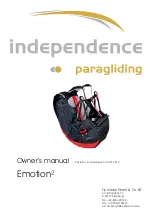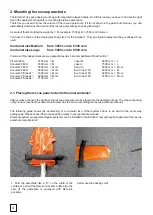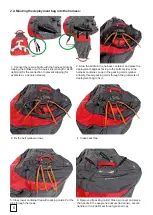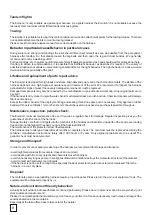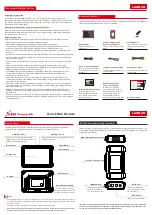
With the harness system Emotion² you bought one of the most comfortable and functional allround harness, which is
available on the market at present. Thank you for your confidence. Please read this instruction carefully and consider,
that Independence is not liable for accidents and damage, which result from disregarding of this operating instructions.
Technical description:
The Emotion² is a paragliding harness for the use in a not motorized paraglider. Certification No.: EAPR GZ-
0173/14.
a)
b) Rescue system release handle
c) Chest buckle with safety T-lock
d) Lateral chest belt / adjustment buckle
e) Main suspension
f) Outlet for speed system
g) Pulley for speed bar line
h) Shoulder belt with adjustment buckle
i) Suspension for rescue parachute
connection bridle (covered)
Rescue system container
j) Airbag Protector
k) Seatboard inclination adjustment
l) Fixation for stirrup
m)Fixation for speed bar line
n) Air intake / valve protector
o) Storage bag
p) Deployment bag with handle
1) Schematic description of how to mount the speedbar
(Components partly covered)
Overview:
technical datas
Small
Medium
Large
max. load
120 daN
120 daN
120 daN
harness weight
3,6 kg
3,8 kg
4,1 kg
hangpoint height incl. carabiner
48 cm
50 cm
52 cm
protector system
Mousse Bag
Mousse Bag
Mousse Bag
English version:
2
i)
f)
g)
h)
h)
j)
k)
o)
1)
a)
f)
e)
d)
b)
j)
h)
c)
k)
m)
l)
d)
p)
c)
n)
m)
m)
l)
l)
e)
e)
Adjustment possibilities:
Adjustment possibilities are existing at the shoulder belts, the chest belt, the lateral chest belts, leg straps, seat bord/
lordosis inclination.
By the versatile adjusting possibilities of the Emotion² we recommend in any case that all adjustments and settings are
done in a simulator
before
the first flight to guarantee an optimal comfort.
The buckles of the chest belt / leg straps are secured against unintentional opening. To open these buckles you have to
push both buttons of the buckle at the same time.
Adjust the chest belt:
If the chest belt is closed, also the falling out safety device (Safe-T-System) is closed. The Click-Lock buckles must be
closed audibly! The length of the chest belt can be adjusted and should not be tightened too much.
Adjusting the shoulder belts:
Please note that with correct adjusting the shoulder belts are felt with light pressure on the shoulders. With the shoulder
belts you adjust the harness on the pilot’s heigh, but also you adjust the seating position between upright and lying.
Adjusting the lateral chest belts:
Adjusting the lateral chest belts take place as the third step and offers on one side again the variation of the seating
position. On the other hand you adjust with the lateral chest belts the most comfortable seating position. During the
adjustment pay attention to the fact that the body load is distributed equal on shoulder belt and lateral chest belt.
Adjusting of the leg belts:
Adjusting the seatboard inclination / lordosis:
The inclination of the seat board/lodorsis is to be adjusted with the belt (k).
Attaching the speed bar:
You can see in the schematic description 1) how the speedbar rope is running. The rope of the speedbar runs down from
the risers to the pulley above the seatboard (g). The speedbar rope leaves the harness at the frontal edge of the seat
board through the ring (l). Then the rope gets connected with the speedbar.
The length of the speedbar’s line must be adjusted in a simulator before flight!!!
When you put the harness on, please take care that the Click-Lock-buckles are closed correct and audible. The leg belts
should be fastened tight but should leave your legs still enough space to move during take off and landing phase.
3
Emotion² Rucksack

